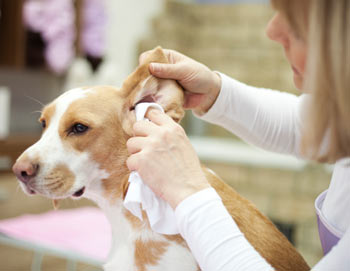How to Clean a Dog's Ears

Sometimes, dogs need their ears cleaned. It could be that your dog has an ear infection, and cleaning is necessary to aid in its treatment. Or maybe you have a dog that likes to swim, and using a cleaner that contains a drying agent after swimming helps keep them from getting infected. Or maybe routine cleanings are necessary just to keep dirt and debris out of your dog's ears.
How to Clean Dogs' Ears
Ear cleaning can be a bit scary for some dog-owners, so we've written a checklist to give you the basics of how to do it.
Don't use water to clean your dog's ears. Water trapped in the ear canal can lead to an ear infection. Check with your veterinarian for the right ear cleaner for your dog.
✓ Gather your supplies. You'll need ear cleaner and cotton balls or gauze squares. For some infections, your veterinarian may recommend a particular ear cleaner with a certain pH. Otherwise, choose a gentle, non-medicated canine ear cleaner. You may wish to wear gloves while cleaning your dog's ears.
✓ Recruit a helper. It will be much easier to clean your dog's ears if you have someone to help you hold her still or at least keep her from walking away from you.
✓ Have your dog sit. You will want to be positioned beside her, facing the ear you want to clean first.
✓ Use your non-dominant hand to lift your dog's ear if necessary. If your dog has floppy ears, they'll probably need cleaning more often than if they stand up. You'll need to lift the ear flap to access the ear canal.
✓ Place the tip of the bottle of ear cleaner gently into the ear opening with your dominant hand. You don't need to push or go in too far.
✓ Squeeze a couple of squirts of ear cleaner into the ear. You may want to practice first by squirting some ear cleaner out into the garbage can, so you can see how hard you need to push on the bottle to get the desired amount of cleaner to come out.
✓ Remove the bottle, quickly close the ear flap, and rub the base of the ear gently for 60 seconds or so. A dog's ear canal goes in from the outside just a short distance, then it makes a sharp turn and continues to go in toward the eardrum. Massaging the ear's base gets the cleaner to move all the way down into the ear canal and break up dirt, debris, and infection that might be there.
✓ Move back and let your dog shake her head. Your dog will be wanting to shake her head, and once you've done your massage, you can let her do it briefly. Take care, because ear cleaner and debris may fly out, so averting your eyes is best.
✓ Use cotton or gauze to wipe out the ear. Wipe out any remaining debris and liquid that has floated up to the outer ear canal with cotton or gauze.
Do not use cotton swabs (Q-tips) to clean your dog's ears. You may push debris into the eardrum and damage it.
You May Also Like These Articles:
Dog Shaving: Helpful or Harmful?
Foxtails: A Summertime Hazard for Dogs
Dog Fleas: How to Look for Fleas on Your Dog
How to Cope with Canine Anxiety and Fear by Using Adaptil(TM) (Formerly called D.A.P)
Disclaimer: This website is not intended to replace professional consultation, diagnosis, or treatment by a licensed veterinarian. If you require any veterinary related advice, contact your veterinarian promptly. Information at DogHealth.com is exclusively of a general reference nature. Do not disregard veterinary advice or delay treatment as a result of accessing information at this site. Just Answer is an external service not affiliated with DogHealth.com.
Notice: Ask-a-Vet is an affiliated service for those who wish to speak with a veterinary professional about their pet's specific condition. Initially, a bot will ask questions to determine the general nature of your concern. Then, you will be transferred to a human. There is a charge for the service if you choose to connect to a veterinarian. Ask-a-Vet is not manned by the staff or owners of DogHealth.com, and the advice given should not delay or replace a visit to your veterinarian.



